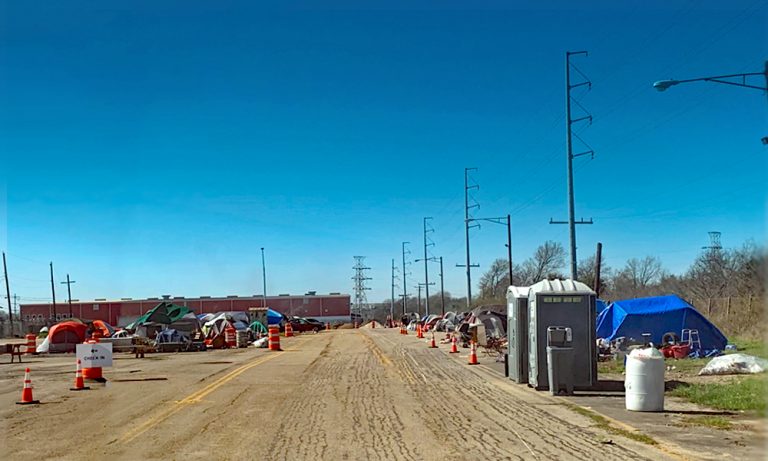

File photo
The first phase of the Austin City Council’s HEAL Initiative, designed to address unsheltered homelessness in Austin, will be complete by late summer, according to a blueprint published by the City’s Homeless Strategy Office today, April 6.
During today’s Work Session, Dianna Grey, the City of Austin’s Homeless Strategy Officer, updated the City Council on plans to focus on re-housing individuals living at four encampments in priority locations during Phase 1 of the Initiative.
Under the plan, the sites of the encampments, in south central, east, downtown, and northwest Austin, would be established as non-camping areas by the end of August, following extensive efforts to relocate residents through the provision of dedicated housing resources, as well as temporary shelter where needed.
“What we’re seeing now is our community coming together to put the resources behind the proven housing and outreach strategies identified in Austin and across the country,” said Dianna Grey, City of Austin Homeless Strategy Officer. “HEAL is, by design, an iterative and collaborative initiative that will not only have an immediate impact on the lives of people living in unstable and inhumane conditions, but will also build the entire system’s capacity to make homelessness rare, brief, and non-recurring.”
A preliminary budget of $4.3 million has been identified and the negotiation of contracts and agreements for outreach, shelter, case management, housing, and other support has begun. Funding actions will appear on City Council agendas over the next month.
Today’s Work Session briefing follows Austin City Council’s adoption of Resolution No. 20210204-049 in February 2021, directing the implementation and funding of a Housing-Focused Encampment Assistance Link (HEAL) Initiative designed to connect individuals living in designated encampments immediately to housing or housing-focused shelter and supportive services.
It will use best practices and lessons learned from previous Austin initiatives including those addressing veteran homelessness, youth homelessness, and Guided Path encampment strategy.
Homeless Strategy Division staff have engaged key partners including housing and service providers, as well as other City of Austin departments engaged in public space management.
Working with the Austin Homeless Advisory Council (AHAC), they also obtained input from people with lived experience of homelessness regarding approaches, resources, and solutions for connecting individuals living in encampments to services that lead to ending unsheltered homelessness. Engagement will continue throughout the process.
Encampment Outreach & Engagement Activities – Early needs assessment, completion of site-specific census, engagement and relationship-building with occupants of encampments, meeting immediate basic needs, supporting individual decision-making, communicating timeline and process for encampment relocation.
Temporary Shelter Resources – Providing immediate access to very low-barrier shelter with direct connections to housing resources is integral to the success of this strategy. A potential central shelter site has been identified and staff is in the process of solidifying the contracting process for housing-focused shelter for Phase 1.
Permanent Housing – HSD expects to contract with a service provider or providers to dedicate Diversion and Rapid Rehousing program capacity to the HEAL Initiative. Permanent Supportive Housing programs will also form part of the strategy to connect people to safe and stable housing.
Site Assessment, Improvement, Activation, and Compliance – Portions of this planning will be carried out largely in coordination with the entity or jurisdiction that owns or manages the site, such as the Parks and Recreation Department, Austin Public Library, or outside entities such as the Texas Department of Transportation.
The initiative will focus on the utilization of effective, non-punitive measures to encourage voluntary compliance once camping is no longer permitted in a particular site.
The plan outlined a number of potential strategies to achieve this goal, including robust communication efforts (in the form of personal outreach, distribution of written materials, and signage), site improvements (such as additional community amenities or landscaping), and the organization of community activities or events.
Where a site poses significant health and/or safety risks to potential occupants, or where the location, character, or use of the site precludes other strategies, measures could be taken to restrict access, either temporarily or permanently.
The San Marcos City Council received a presentation on the Sidewalk Maintenance and Gap Infill…
The San Marcos River Rollers have skated through obstacles after taking a two-year break during…
San Marcos Corridor News has been reporting on the incredible communities in the Hays County…
Visitors won't be able to swim in the crystal clear waters of the Jacobs Well Natural…
Looking to adopt or foster animals from the local shelter? Here are the San Marcos…
The Lone Star State leads the nation in labor-related accidents and especially workplace deaths and…
This website uses cookies.